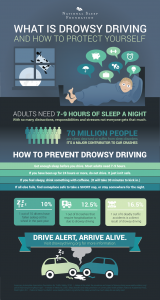Daylight Savings Time begins on March 13th this year. This means one less hour of sleep and an abrupt change to your sleep schedule, so make sure to be extra alert during your morning drive.
Depending on what time you leave your house in the morning, it may be dark out. According to the National Highway Traffic Safety Association, driving in the dark is more dangerous than driving during the day.
A study conducted by Current Biology states that the Spring Daylight Savings Time (DST) transition acutely increases the risk of a fatal traffic accident by 6% in the U.S. The study also states that Spring-DST-transition-associated fatal accident risk is highest in the morning.
Did you know?
According to the National Safety Council:
- Annually, about 100,000 police-reported, drowsy driving crashes have resulted in 800 fatalities and almost 50,000 injuries (National Highway Traffic Safety Admi
 nistration)
nistration) - It is estimated that 328,000 drowsy driving crashes occur annually.
- NHTSA estimates fatigue-related crashes resulting in injury or death cost society $109 billion annually.
- 50% or more of drowsy driving crashes are drivers under the age of 25.
According to the CDC, drowsy driving is similar to drunk driving.
- Being awake for at least 18 hours is the same as having a blood alcohol content (BAC) of 0.05%.
- Being awake for at least 24 hours is equal to having a blood alcohol content of 0.10%. This is higher than the legal limit (0.08% BAC) in all states.
Four Steps to Prevention, according to the CDC:
- Get enough sleep! Most adults need at least 7 hours of sleep each night, while adolescents need at least 8 hours.
- Develop good sleeping habits such as sticking to a sleep schedule.
- If you have a sleep disorder or have symptoms of a sleep disorder such as snoring or feeling sleepy during the day, talk to your physician about treatment options.
- Avoid drinking alcohol or taking medications that make you sleepy. Be sure to check the label on any medications or talk to your pharmacist.
A Glaring Reminder
In contrast to the darker conditions during the morning commute, the change of time means more sunlight in the evening. The sun is positioned lower in the sky, meaning that you could be staring straight into it as you drive.
AAA offers these tips for motorists when driving into the sun:
• Utilize your sun visor – it can help to block out the sun.
• Invest in polarized sunglasses – they can help reduce glare.
• Drive with your headlights on to increase your visibility to other drivers.
• Keep your windshield clean, inside and out.
The National Sleep Foundation’s Sleep Awareness Week begins at this time, and runs from March 13-19, 2022. You can visit their website for infographics and sleep tips to share with your colleagues, friends, and family about the importance of sleep health.



